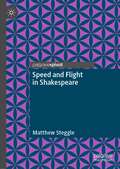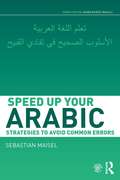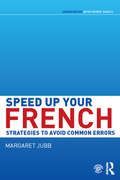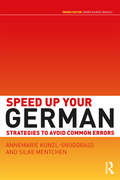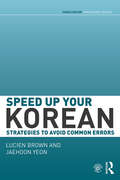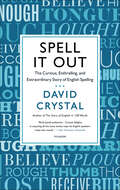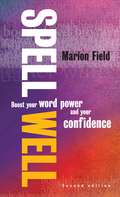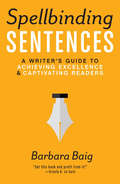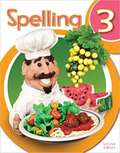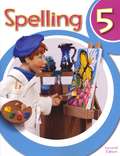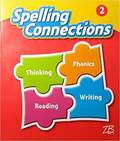- Table View
- List View
Speed and Flight in Shakespeare
by Matthew SteggleShakespeare's plays are fascinated by the problems of speed and flight. They are repeatedly interested in humans, spirits, and objects that move very fast; become airborne; and in some cases even travel into space. In Speed and Flight in Shakespeare, the first study of any kind on the subject, Steggle looks at how Shakespeare’s language explores ideas of speed and flight, and what theatrical resources his plays use to represent these states. Shakespeare has, this book argues, an aesthetic of speed and flight. Featuring chapters on The Comedy of Errors, A Midsummer Night’s Dream, Romeo and Juliet, Henry V, Macbeth and The Tempest, this study opens up a new field around the ‘historical phenomenology’ of early modern speed.
Speed up your Arabic: Strategies to Avoid Common Errors
by Sebastian MaiselPronunciation, spelling, the concept of roots and patterns and idomatic phrases are just some of the areas that cause confusion for students of Arabic. Learning how to avoid the common errors that arise repeatedly in these areas is an essential step in successful language learning. Speed Up Your Arabic is a unique and innovative resource that identifies and explains the most commonly made errors, enabling students to learn from their mistakes and enhance their understanding of the Arabic language. Each of the nine chapters focuses on a grammatical category where English speakers typically make mistakes in Arabic. Each chapter is divided into sections that classify the concepts and errors into subcategories. Full explanations are provided throughout with clear, comprehensive examples and exercises to help the learner gain an in-depth understanding of Arabic grammar and usage. Key features: Carefully selected grammar topics and examples based on the most commonly made errors Comprehensive explanations of the most difficult grammar points help learners gain an in-depth understanding of Arabic grammar and usage. Exercises throughout reinforce learning and link theory to practice A complete answer key making it ideal for self-study A glossary of grammatical terms, an Arabic-English glossary and a bibliography to aid learning Useful drills and listening samples available for free download at http://www.routledge.com/books/details/9780415660556/ Suitable both for classroom use or self-study, Speed Up Your Arabic is the ideal resource for all intermediate learners of Arabic wishing to refine their language skills.
Speed up your French: Strategies to Avoid Common Errors (Speed Up Your Language Skills Ser.)
by Margaret JubbSpeed up your French is a unique and innovative resource that identifies and explains the errors most commonly made by students of French. From false friends to idiomatic expressions and the use of prepositions, each of the nine chapters focuses on an aspect of the language where English speakers typically make mistakes. Full explanations are provided throughout with clear, comprehensive examples, enabling students to acquire a surer grasp of French vocabulary and idiom, as well as grammar. Key Features: carefully selected grammar topics and examples based on the most commonly made errors extensive exercises and answer key to reinforce learning, link theory to practice and promote self-study use of mnemonic devices, including visual illustrations, to aid understanding Supplementary exercises and answer key available at www.routledge.com/cw/Jubb Suitable both for classroom use or self-study, Speed up your French is the ideal resource for all intermediate learners of French wishing to refine their language skills.
Speed up your German: Strategies to Avoid Common Errors
by Silke Mentchen Annemarie Kunzl-SnodgrassSpeed Up Your German is a unique and innovative resource that identifies and explains the errors most commonly made by learners of German, enabling students to learn from their mistakes while enhancing their understanding of the German language. Each of the eighteen chapters focuses on a grammatical category where English speakers typically make mistakes. Each chapter is subdivided into two levels: Level 1 explains the root cause of the error while level 2 goes deeper into the grammar allowing students to choose the level they want to work at. Each point is clearly explained and exemplified and a range of exercises reinforce learning. Suitable both for classroom use or self-study, Speed Up Your German is the ideal resource for all intermediate learners of German wishing to refine their language skills.
Speed up your Korean: Strategies to Avoid Common Errors
by Jaehoon Yeon Lucien BrownWord order, honorifics, terms of addresses and idiomatic expressions are just some of the areas that cause confusion for students of Korean. Learning how to avoid the common errors that arise repeatedly in these areas is an essential step in successful language learning. Speed Up Your Korean is a unique and innovative resource that identifies and explains these errors, enabling students to learn from their mistakes while enhancing their understanding of the Korean language. Key features: Carefully selected grammar topics and examples based on the most commonly made errors Comprehensive explanations of the most difficult grammar points help learners gain an in-depth understanding of Korean grammar and usage. Exercises throughout reinforce learning and link theory to practice Suitable both for classroom use or self-study, Speed Up Your Korean is the ideal resource for all intermediate learners of Korean wishing to refine their language skills.
Spekulationskritik in fiktionalen und faktualen Darstellungen des Gründerkrachs 1873 und der Finanzkrise 2008
by Patrick Galke-JanzenMit der Analyse fiktionaler Darstellungen, genauer Erzählungen, der Finanzkrise 2008 und des Gründerkrachs 1873 leistet die vorliegende Arbeit einen Beitrag zur Literarischen Ökonomik, indem sie untersucht, ob und wie Finanzkrisenromane ökonomisches Wissen ihrer Zeit produktiv aufnehmen und andererseits mögliches eigenes Wissen als Fundus für ihre Leser bereitstellen. Patrick Galke-Janzen zeigt, dass der Spekulant und die Spekulation für zahlreiche literarische Reflexionen Anlass gibt und man geradezu von einem eigenen fiktionalen Spekulationsdiskurs ausgehen muss, der im deutschsprachigen Raum vor allem betont, welche Gefahren der überkommenen Ordnung und der als realistische Warenökonomie verstandenen Volkswirtschaft durch Spekulation und Spekulanten drohen. Erzählungen über den Gründerkrach und die Finanzkrise 2008 fordern implizit und explizit zu einer Entscheidung über den Stellenwert und die soziale Praxis ökonomischer Spekulation auf und schließen dabei an einen diachronen Diskurs über die Gefährdung des Sozialen durch ökonomische Spekulation an.
Spell It Out: The Curious, Enthralling, and Extraordinary Story of English Spelling
by David CrystalThe fascinating and surprising history of English spelling from David Crystal, everyone's favorite expert logophileWith The Story of English in 100 Words, David Crystal took us on a tour through the history of our language. Now, with Spell It Out, he takes on the task of answering all the questions about how we spell: "Why is English spelling so difficult?" Or "Why are good spellers so proud of their achievement that when they see a misspelling they condemn the writer as sloppy, lazy, or uneducated?" In thirty-seven short, engaging and informative chapters, Crystal takes readers on a history of English spelling, starting with the Roman missionaries' sixth century introduction of the Roman alphabet and ending with where the language might be going. He looks individually at each letter in the alphabet and its origins. He considers the question of vowels and how people developed a way to tell whether or not it was long or short. He looks at influences from other cultures, and explains how English speakers understood that the "o" in "hopping" was a short vowel, rather than the long vowel of "hoping". If you've ever asked yourself questions like "Why do the words "their", "there" and "they're" sound alike, but mean very different things?" or "How can we tell the difference between "charge" the verb and "charge" the noun?" David Crystal's Spell It Out will spell it all out for you.
Spell Well, 2nd Edition: Boost Your Word Power And Your Confidence
by Marion FieldIt is true. A well-written letter is taken far more seriously than one using misspelt words. Research shows that people automatically assume you're more intelligent, and they'll take notice of you in a way they never did before. Now, with the help of this book you can discover the power of words for yourself. There are checklists and steps that ensure you'll soon be writing with much greater confidence.Contents: 1. Identifying different sounds; 2. Checking capital letters; 3. Forming plurals and changing verbs; 4. Using prefixes, suffixes and hyphens; 5. Sorting out the changes; 6. Avoiding common mistakes; 7. Using apostrophes and abbreviations; 8. Revising chapters 1-7; 9. Exploring the dictionary; 10. Discovering the thesaurus; 11. Enhancing your writing; 12. Looking at American spelling; 13. Exploring new words, jargon and slang.
Spell Well, 2nd Edition: Boost your word power and your confidence
by Marion FieldIt is true. A well-written letter is taken far more seriously than one using misspelt words. Research shows that people automatically assume you're more intelligent, and they'll take notice of you in a way they never did before. Now, with the help of this book you can discover the power of words for yourself. There are checklists and steps that ensure you'll soon be writing with much greater confidence.Contents: 1. Identifying different sounds; 2. Checking capital letters; 3. Forming plurals and changing verbs; 4. Using prefixes, suffixes and hyphens; 5. Sorting out the changes; 6. Avoiding common mistakes; 7. Using apostrophes and abbreviations; 8. Revising chapters 1-7; 9. Exploring the dictionary; 10. Discovering the thesaurus; 11. Enhancing your writing; 12. Looking at American spelling; 13. Exploring new words, jargon and slang.
Spellbinding Sentences: A Writer's Guide to Achieving Excellence and Captivating Readers
by Barbara BaigElevate Your Writing From So-So To Spectacular!Great writing requires more than an original idea, compelling characters, or a scintillating plot. An author needs all of these to be successful, but writing--and writing well--also demands an entirely different skill set.Spellbinding Sentences arms you with the tools you need to master the power of the English language. In this book, you'll learn the different qualities of words and the many ways those words can be combined to create sentences that hook readers. You'll emulate sentences from your favorite writers, practice proven techniques, and develop your skills one step at a time. The result? Your ability to craft excellent sentences will become second nature--and those sentences will hold your readers spellbound, page after page."Barbara Baig's Spellbinding Sentences is a tribute to the pleasure and vitality of the English language. Never prescriptive and always clear, this enlightening book is sure to help all those wishing to add grace and strength to their writing." --Jane Brox, award-winning author of Brilliant: The Evolution of Artificial Light, one of TIME magazine's top ten nonfiction books of 2010"Spellbinding Sentences is sophisticated and down-to-earth at the same time. Barbara Baig has distilled decades of experience into this wise book." --Edward Dolnick, New York Times best-selling author of The Rescue Artist: A True Story of Art, Thieves, and the Hunt for a Missing Masterpiece
Spellbound: Seven Principles of Illusion to Captivate Audiences and Unlock the Secrets of Success
by David KwongA professional magician and illusionist—the head magic consultant for the hit film Now You See Me—reveals how to bridge the gap between perception and reality to increase your powers of persuasion and influence.David Kwong has astounded corporate CEOs, TED talk audiences, and thousands of other hyper-rational people, making them see, believe, and even remember what he wants them to. Illusion is an ancient art that centers on control: commanding a room, building anticipation, and appearing to work wonders. Illusion works because the human brain is wired to fill the gap between seeing and believing. Successful leaders—like Steve Jobs, Warren Buffett, and Ted Turner—are masters of control and command who understand how to sway opinions and achieve goals.In his years of research and practice, David has discovered seven fundamental principles of illusion. With these rules anyone can learn to:Mind the Gap—recognize and employ the perceptual space between your audience’s ability to see and their impulse to believe.Load Up—prepare to amaze your audience.Write the Script—discover the importance of shaping the narrative that surrounds your illusion.Control the Frame—explore the real life value of a magician’s best friend: misdirection.Design Free Choice—command your audience by giving them agency.Employ the Familiar—take secret advantage of habits, patterns, and audience expectations.Conjure an Out—develop backup plans that will keep you one, two, three, or more steps ahead of the competition.With Spellbound you’ll discover a different way to sell your idea, product, or skills, and make your best shot better than everyone else’s.
Spellbound: The Surprising Origins and Astonishing Secrets of English Spelling
by James EssingerFollowing the continued success of a wave of spelling and punctuation titles published in the past eighteen months, James Essinger's 'Spellbound' is an engagingly written, unique and comprehensive account of why the English language is riddled with words that are difficult to spell. Starting with an analysis of the first writing systems, via the origins of English spelling and how this has evolved, the book concludes with intriguing stories of how the spelling of many hard-to-spell words evolved.
Spelling 4 Worktext, Second Edition
by Bju Press StaffThe Spelling 4 Student Worktext has been completely revised to include colorful worktext pages with activities such as word sorting, word studies, proofreading, dictionary skills, and writing to strengthen spelling and communication skills. Thirty-two weekly spelling lists are included, and each list contains approximately 20 words.
Spelling 5 Student Worktext (Second Edition)
by Bju PressThe Spelling 5 Student Worktext has been completely revised to include colorful worktext pages with activities such as word sorting, word studies, proofreading, dictionary skills, and writing to strengthen spelling and communication skills. Thirty-two weekly spelling lists are included, and each list contains approximately 20 words.
Spelling 6 Student Worktext
by Sandra Bircher Carol Arrington Ann Carruthers Kelly Payne [et al.]Building upon students' familiarity with word patterns, Spelling 6 covers the etymology of English with chapters focusing on derivational suffixes, Greek word parts, Latin prefixes, Latin suffixes, and Latin word roots. Lessons are centered on a weekly list of pattern words with built-in review words. Students will sort their pattern words under the correct letter pattern, organize words by syllables, write in the missing syllable to complete words, complete sentences, match words with their definitions, edit and proofread passages, complete writing exercises, and more. 32 weekly lists are provided. 176 pages with index and glossary, softcover. Second Edition.
Spelling Connections 3: A Word Study Approach
by J. Richard GentryNIMAC-sourced textbook <p>Grade 3
Spelling Connections 6
by J. GentrySpelling and the Writing Process, Spelling and Writing Ideas, Manuscript Handwriting Models, Cursive Handwriting Models, High-Frequency Writing Words,
Spelling Connections Grade 2 Student Edition
by Zaner-BloserSpelling Connections Grade 2 Student Edition
